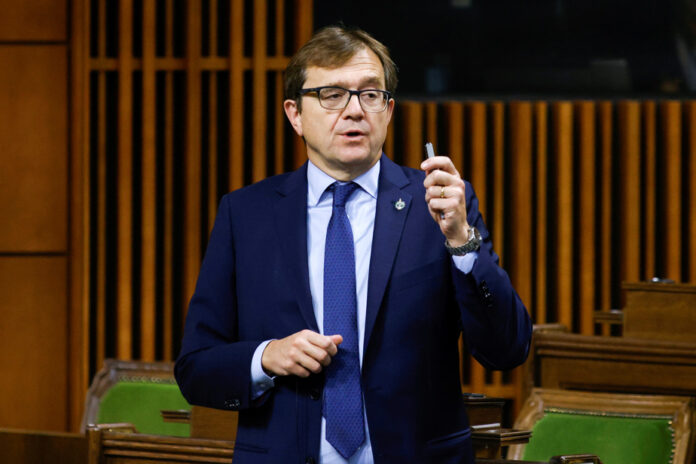(OTTAWA) Natural Resources Minister Jonathan Wilkinson introduced legislation Thursday to implement his sustainable jobs plan, but a battle looms on the horizon with the Alberta government. Premier Danielle Smith calls it an “unconstitutional and existential threat” to her province’s economy.
She is calling for the power to appoint members of the new advisory committee that will be created once the bill is passed, so that it takes into account her government’s plan to reduce greenhouse gas emissions from the energy sector . The plan relies on funding new technologies like carbon capture and storage and increasing exports of liquefied natural gas.
If she finds the recommendations to be “inconsistent” with this plan or “interfere” with her jurisdiction over natural resources, “Alberta will in no way recognize the legitimacy of these recommendations,” the premier said. in a statement Thursday afternoon.
The oil, gas and mining industries employ about 138,000 people in the province and the average wage exceeds $46 an hour, according to the Alberta Department of Labor. It’s also a huge source of revenue for the government, which earned $11.6 billion in royalties from tar sands oil extraction in 2021-22.
Mr. Wilkinson, who is due to meet with Ms. Smith in Calgary on Monday, said he was confident he could convince her of the merits of Bill C-50. “The language around sustainable jobs is one that she agrees with and that emphasizes the economy of the future to create good jobs and opportunities,” he said. I think that’s something we all agree with. »
“I know people are cynical about the fact that we’ve renamed it,” Labor Minister Seamus O’Regan said at a press conference. We no longer call it [the plan] for just transition, we call it [the plan] for sustainable jobs, and that is for a very good reason. »
The term “just transition” is used internationally to describe the protection of the workforce affected by the shift to a green economy, but it was seen in Alberta as a threat to jobs in the manufacturing sector. energy.
In a letter sent to Prime Minister Justin Trudeau in February, Danielle Smith asked her not to table the bill or she would refuse to work with the federal government to capture and store carbon emitted by the oil industry. and gas.
Minister Jonathan Wilkinson’s plan received little attention when it was unveiled on February 17, the same day as the Rouleau Commission’s report was released. It provides 10 courses of action until 2025 to requalify workers. Thereafter, subsequent governments should produce a new plan every five years.
“The law itself is necessary because it will ensure that future governments will continue to support Canadian workers in a changing global economy,” Wilkinson said at a press conference.
“When should this bill pass second reading?” asked House of Commons Speaker Anthony Rota after the bill was introduced Thursday morning.
“Never,” we heard from the Conservative benches.
The bill drafted in collaboration with the New Democratic Party (NDP) will serve to implement the plan for sustainable jobs. This is one of the points of the agreement which allows Justin Trudeau’s Liberals to govern as if they were a majority until 2025.
“Too often in an economic transition, workers are left behind,” said NDP MP Bill Blaikie, who attended the press conference alongside ministers Wilkinson and O’Regan. They will now have a voice by being at the table with government and industry through their union representatives. The bill has the support of the Canadian Labor Congress and Unifor.
Among other things, it will make it possible to create a secretariat to oversee training programs that will enable workers in the hydrocarbons industry to retrain, a Partnership Council that will provide advice to the government, and will require the production of a five-year plan starting of 2025 for the creation of sustainable jobs.
The United Steelworkers remain skeptical, however. He would have liked the bill to define a comprehensive industrial strategy with more investment in clean technologies, a commitment to bring offshore manufacturing jobs back to Canada, the obligation to use Canadian materials in infrastructure projects federal government and a strategy to promote products made here, such as green aluminium, elsewhere in the world.















